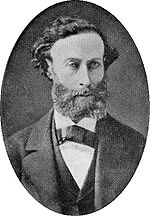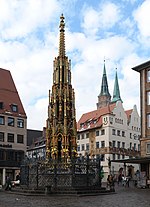Nuremberg ( NURE-əm-burg; German: Nürnberg [ˈnʏʁnbɛʁk] ; in the local East Franconian dialect: Nämberch [ˈnɛmbɛrç]) is the largest city in Franconia, the second-largest city in the German state of Bavaria, and its 545,000 inhabitants make it the 14th-largest city in Germany.
Nuremberg sits on the Pegnitz, which carries the name Regnitz from its confluence with the Rednitz in Fürth onwards (Pegnitz→ Regnitz→ Main→ Rhine→ North Sea), and on the Rhine–Main–Danube Canal, that connects the North Sea to the Black Sea. Lying in the Bavarian administrative region of Middle Franconia, it is the largest city and unofficial capital of the entire cultural region of Franconia. The city is surrounded on three sides by the Reichswald (de), a large forest, and in the north lies Knoblauchsland (garlic land) (de), an extensive vegetable growing area and cultural landscape.
The city forms a continuous conurbation with the neighbouring cities of Fürth, Erlangen and Schwabach, which is the heart of an urban area region with around 1.4 million inhabitants, while the larger Nuremberg Metropolitan Region has a population of approximately 3.6 million. It is the largest city in the East Franconian dialect area (colloquially: "Franconian"; German: Fränkisch).
Nuremberg and Fürth were once connected by the Bavarian Ludwig Railway, the first steam-hauled and overall second railway opened in Germany (1835). Today, the U1 of the Nuremberg Subway, which is the first German subway with driverless, automatically moving railcars, runs along this route. Nuremberg Airport (Flughafen Nürnberg "Albrecht Dürer") is the second-busiest airport in Bavaria after Munich Airport, and the tenth-busiest airport of the country.
Institutions of higher education in Nuremberg include the University of Erlangen-Nuremberg (Friedrich-Alexander-Universität Erlangen-Nürnberg), Germany's 11th-largest university, with campuses in Erlangen and Nuremberg and a university hospital in Erlangen (Universitätsklinikum Erlangen), Technische Hochschule Nürnberg Georg Simon Ohm and Hochschule für Musik Nürnberg. The Nuremberg exhibition centre (Messe Nürnberg) is one of the biggest convention center companies in Germany and operates worldwide.
Nuremberg Castle and the city's walls, with their many towers, are among the most impressive in Europe. Staatstheater Nürnberg is one of the five Bavarian state theatres, showing operas, operettas, musicals, and ballets (main venue: Nuremberg Opera House), plays (main venue: Schauspielhaus Nürnberg), as well as concerts (main venue: Meistersingerhalle). Its orchestra, the Staatsphilharmonie Nürnberg, is Bavaria's second-largest opera orchestra after the Bavarian State Opera's Bavarian State Orchestra in Munich. Nuremberg is the birthplace of Albrecht Dürer and Johann Pachelbel. 1. FC Nürnberg is the most famous football club of the city and one of the most successful football clubs in Germany. Nuremberg was one of the host cities of the 2006 FIFA World Cup.











